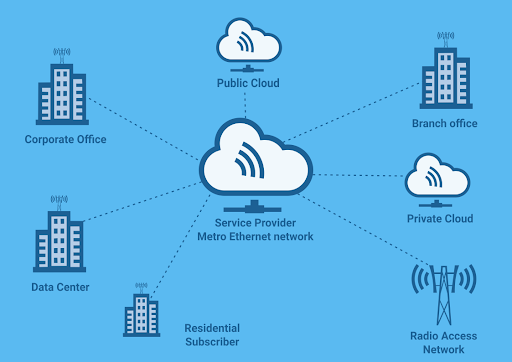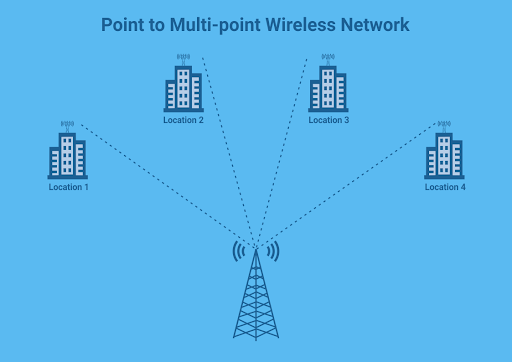
Smart cities aim to improve urban life by leveraging modern technology to create efficient, responsive, and sustainable environments. A critical element in enabling these advanced systems is connectivity.
Smart cities strongly rely on high-speed and reliable Internet infrastructure for the Internet of Things (IoT), industrial systems, and other digital services.
One of the most effective solutions for smart city connectivity is Metro Ethernet. Metro Ethernet presents an effective solution for smart city connectivity. No wonder the market size is projected to reach $113300.89 million by 2031 at a rapid annual growth rate of 10.7%.
With metro ethernet connections, smart cities have the robust, flexible, and scalable network that they need to thrive.
This article explores the role of metro ethernet in supporting smart cities, its benefits, and why it's the right choice for enhancing IoT and industrial systems.
What is Metro Ethernet?
Metro Ethernet is a network that connects users within a metropolitan area through ethernet technology, which is commonly used in local area networks (LANs). However, when applied at a larger scale, Metro Ethernet provides city-wide or even regional connectivity.
There are different types of Metro Ethernet services based on how they are structured:
Ethernet Line Service (E-Line):
E-line is a point-to-point connection that links two locations. It's like having a direct, private link between two sites, allowing for secure, high-speed data transfer.
E-Line can be used in smart cities to connect specific systems like traffic control centers, energy management hubs, or emergency response centers, ensuring real-time, secure communication between critical locations.
Ethernet Tree Service (E-Tree):
This is a point-to-multipoint network, where one location (like a central data center) connects to multiple sites (like smaller city branches).
As seen above, the E-tree model is often used in IoT systems where sensors and devices report back to a central hub.
Ethernet LAN Service (E-LAN):
E-LAN is a multipoint-to-multipoint network, allowing multiple sites to connect as if they are on the same LAN.
E-LAN is particularly useful for smart cities where various systems, like traffic control and energy management, need to communicate across different locations.
Ethernet Access Service (E-Access):
E-Access provides wholesale connectivity between different networks. It enables one service provider to extend its network reach by connecting to another provider's network through a standardized Ethernet interface. This service is useful in situations where a provider needs to offer Ethernet services in locations where they don't have direct infrastructure.
Each of these Metro Ethernet services can be adapted to suit the needs of different smart city applications, offering a range of options depending on the size and scale of the deployment.
How Does Metro Ethernet Work?
Metro Ethernet operates similarly to the traditional Ethernet technology used in offices and homes, but it is scaled up to provide connectivity over large distances, often spanning entire cities.
Metro Ethernet creates a high-speed , wide-area network that connects multiple locations within a city or region. With this, businesses and organizations to connect their various offices or sites as if they were on the same local network, even if they're physically far apart.
Metro Ethernet supports various services like internet access, voice over IP (VoIP), file sharing, and private line connections. The technology uses switches and routers to direct traffic efficiently across the network, ensuring data reaches its intended destination quickly and securely.
Here’s a simple illustration of how a typical metro ethernet works:
Metro Ethernet is managed by a service provider that maintains the infrastructure and ensures the network's performance.
Uses and Benefits of Metro Ethernet
In smart cities, connectivity is critical. IoT devices like sensors, cameras, and meters generate massive amounts of data that need to be processed and acted upon in real-time. Industrial systems, on the other hand, require reliable, high-speed connections to ensure smooth operations.
Metro Ethernet excels in these areas, offering a range of benefits that make it ideal for smart city applications:
High Speed
Smart cities rely on real-time data to manage everything from traffic lights to public safety systems. With high-speed Metro Ethernet, these systems can transmit data instantly, ensuring that decisions are made quickly and accurately.
Metro Ethernet offers speeds that can range from 10 Mbps to over 100 Gbps, depending on the needs of the city or business. This high-speed connectivity is essential for IoT devices and industrial systems that generate and consume vast amounts of data.
Ease of Use and Management
One of the key advantages of Metro Ethernet is its simplicity. It operates using the same Ethernet protocol that many IT teams are already familiar with, making it easier to manage compared to more complex network architectures.
For smart city administrators, this ease of use means less time spent on troubleshooting and more time focusing on optimizing services like energy distribution, waste management, and public transport systems.
Flexibility
Metro Ethernet is highly flexible, allowing cities to scale their network as needed. This is crucial for smart cities where the number of connected devices is constantly growing. Whether it’s expanding coverage to new areas of the city or addressing the increasing bandwidth demand from more and more devices, Metro Ethernet can easily accommodate these needs.
Also, a smart city network supports a wide variety of critical applications, from low-bandwidth devices like smart meters to high-bandwidth systems like video surveillance. Metro Ethernet can handle this diversity by offering customizable service packages that fit the specific needs of different systems.
Cost-effectiveness
While the initial investment in Metro Ethernet infrastructure may seem high, it is generally more cost-effective in the long run. Traditional networks often require expensive hardware upgrades and complex management systems. Metro Ethernet, on the other hand, uses a simpler, more unified approach that reduces both capital and operational expenses.
For smart cities, which need to connect numerous systems across large areas, Metro Ethernet offers an affordable way to maintain a high-performance network without ongoing high costs. Additionally, service providers often offer scalable pricing models, so cities only pay for the bandwidth and services they need.
Reliability
Metro Ethernet is known for its high reliability. Recent market analysis reveals that 50% of subscribers expect at least 99.99% service availability— and this is what most service providers often offer in service level agreements (SLAs). This level of reliability is critical because city services often need to operate without interruption.
For instance, stable Metro Ethernet connectivity ensures that essential services like emergency response systems are always online or that energy distribution is consistent.
Scalability
As smart cities grow, so do their connectivity needs. Metro Ethernet can scale easily to accommodate more users, devices, and systems. Whether the city is expanding its smart traffic management systems or adding new IoT devices, there’s room for quick adjustments in bandwidth and service levels.
Also, scalability is particularly important in industrial systems, where data demands can fluctuate depending on the time of day or operational requirements. Metro Ethernet's ability to scale up or down as needed ensures that the network remains efficient and cost-effective.
Conclusion
Metro Ethernet is an essential tool for smart cities looking to enhance their connectivity. Its high-speed, reliable, and scalable nature makes it the perfect choice for supporting the growing number of IoT devices and industrial systems that modern cities rely on.
As smart cities continue to evolve, having a solid network foundation like Metro Ethernet is crucial. It not only ensures that current systems operate efficiently but also provides the flexibility needed to support future innovations.





